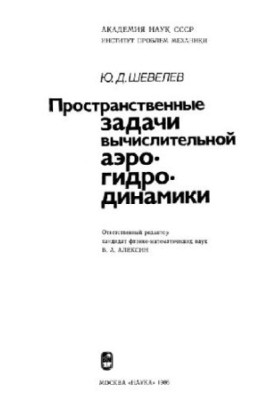Spatial Problems of Computational Aerohydrodynamics
 Instant download
Instant download
after payment (24/7)
 Wide range of formats
Wide range of formats
(for all gadgets)
 Full book
Full book
(including for Apple and Android)
The monograph describes modern approaches to finite-difference methods of solving problems of aerohydrodynamics, discusses issues of approximation, stability and convergence. Numerical modeling is carried out within the framework of various mathematical formulations and approximations. The main regularities of three-dimensional 'disruptive' currents of liquid and gas are considered. Attention is paid to approximate methods for calculating problems and physical features of spatial currents . For specialists in applied mathematics and continuum mechanics. Shevelev Yu . D. , from the introduction:'This book is devoted to the numerical solution of some spatial problems of external aerohydrodynamics. Until recently, the study of currents near moving bodies was limited to relatively simple forms (sphere, cylinder, sharp and blunt cones, etc.). ). The problem of numerical modeling of fluid or gas flows near bodies of real shape (planes, ships, cars, etc.) It is much more difficult. This raises a number of questions related to the modeling of geometry, the construction of coordinate systems. Geometric description of the real model, the construction of a discrete set (grid) is a time-consuming task and requires the use of differential geometry apparatus, tensor analysis. Mathematical questions of the problem of geometry of arbitrary form and construction of curvilinear coordinate systems are considered in Chapter I. Chapter II deals with the computational aspects of various forms of recording equations of motion and boundary conditions in arbitrary (non-orthogonal) coordinate systems for the case of an incompressible liquid and a compressible homogeneous and inhomogeneous gas. Numerical modeling of the problems of aerohydrodynamics is carried out within the framework of various mathematical formulations and approximations. Questions of validity and limits of applicability of mathematical models are discussed. The following chapters (IIIVI) deal with spatial problems for two cases: the outward perfect flow of bodies and the currents in the boundary layer. Attention is paid to finite-difference and integral methods of solving boundary layer problems, the main laws of three-dimensional discontinuous currents. Chapters V and VI are devoted to the numerical calculation of spatial laminar and turbulent currents . Chapters III-VI provide concrete examples of finite-difference methods for solving spatial problems of aerohydrodynamics, discuss the issues of approximation, stability, convergence and implementation of algorithms... The book does not claim to fully cover the whole range of tasks arising from the circumvention of bodies at the angle of attack, and the content is determined by the author's personal interests in solving such problems. Hydromechanics literature
LF/709008431/R
Data sheet
- Name of the Author
- Шевелев Ю.Д.
- Language
- Russian
- Release date
- 1986













